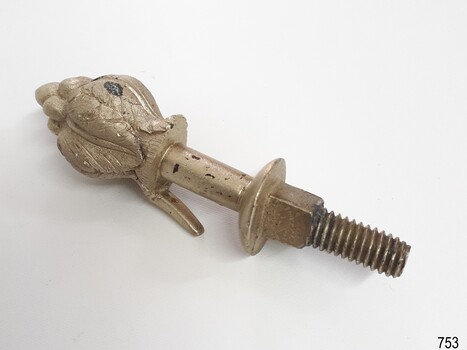Historical information
This ornate fitting for a horse-drawn vehicle was amongst the items recovered from the Schomberg over one hundred years after it was wrecked.
ABOUT THE SCHOMBERG (October 6 to December 27, 1855)-
When the ship Schomberg was launched in 1855, she was considered the most perfect clipper ship ever to be built. James Baine’s Black Ball Line had commissioned her for their fleet of passenger liners. The Aberdeen builders designed her to sail faster than the clippers designed the three-masted wooden clipper ship to be fast. The timber used for the diagonal planking was British oak with layers of Scottish larch. This luxury emigrant vessel was designed for superior comfort. She had ventilation ducts to provide air to the lower decks and a dining saloon, smoking room, library and bathrooms for the first-class passengers.
The master for Schomberg’s maiden voyage was Captain ‘Bully’ Forbes. He drunkenly predicted at her launch that he would make the journey between Liverpool and Melbourne in 60 days. Schomberg departed Liverpool on 6 October 1855 with 430 passengers and 3000 tons of cargo including iron rails and equipment intended the build the Geelong Railway and a bridge over the Yarra from Melbourne to Hawthorn.
The poor winds slowed Schomberg’s sail across the equator. She was 78 days out of Liverpool when she ran aground on a sand spit near Peterborough, Victoria, on 27 December; the sand spit and currents were not marked on Forbes’s map. The ship’s Chief Officer spotted the coastal steamer SS Queen at dawn and sent a signal. The master of the SS Queen approached the stranded vessel and all of Schomberg’s passengers safely disembarked.
In 1975, 120 years after the Schomberg was wrecked, divers from Flagstaff Hill found an ornate communion set at the wreck site along with many other artefacts. In 1978 a diamond ring was discovered under the concretion in the lid of the communion set, which is currently on display. Former Director of Flagstaff Hill, Peter Ronald, had salvaged most of the artefacts from the wreck.
Significance
The Schomberg has historical significance as one of the first luxurious ships built to bring emigrants to Australia to cash in on the gold rush era. And is included on the Victorian Heritage Register (VHR S612). The collection of Schomberg artefacts held at Flagstaff Hill Museum is primarily significant because of the relationship between these recovered items having a high potential to interpret the story of the Schomberg and its foundering during a storm. The shipwreck is of additional historically significance for representing aspects of Victoria’s shipping history and for its association with the first passenger ship, which was designed not only to be the fastest and most luxurious of its day but foundered on its maiden voyage to Australia.
Physical description
Ornate buggy or coach fitting with feather plumes on top, and a screw thread on the bottom. Silver plated,.
Subjects
- warrnambool,
- flagstaff-hill,
- flagstaff-hill-maritime-museum,
- shipwreck-coast,
- flagstaff-hill-maritime-village,
- schomberg,
- shipwrecked-artefact,
- clipper ship,
- black ball line,
- 1855 shipwreck,
- aberdeen clipper ship,
- captain forbes,
- peterborough shipwreck,
- ss queen,
- artifact,
- ornate fitting,
- buggy fitting
References
- Scubadoctor Internet dive site for information on Schomberg wreck
- Exploring Shipwrecks of Western Victoria by Peter Ronald ISBN/ISSN: 0 7316 1922 6 Schomberg; The author's account of recovering artefacts on the Schomberg.
- Victorian Heritage database: Schomberg The shipwreck and its significance to Victoria




